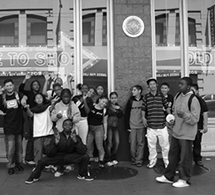 Maureen Benson, principal of the Fremont Federation’s Youth Empowerment School (YES), talked with Laura Flaxman and Horace editor Jill Davidson about YES’s early successes and challenges as a small, autonomous, interconnected school.
Maureen Benson, principal of the Fremont Federation’s Youth Empowerment School (YES), talked with Laura Flaxman and Horace editor Jill Davidson about YES’s early successes and challenges as a small, autonomous, interconnected school.
On Professional Development and Staffing
Academically and instructionally, we are nowhere near where I would like us to be. But creating a cohesive staff takes time, patience, resilience and a commitment to change, within both practice and the system. There seems to be an increase in the amount of stress, especially for the more veteran teachers. Moving our work from a big school mentality to a small school mentality is a huge transition, and I respect that and work hard to honor it.
However, it has been extremely difficult for teachers to convert their practice from the old school expectation of “isolation and seeing 150+ kids per day” to “intimacy in collaboration.” Being observed regularly, having the results of those observations guide the professional development, and having more time with kids than you were used to having all deepen the relationship with and the context of the instruction and behavior management. Formulaic approaches, which used to be the norm for the conveyor belt of kids we would see every day, simply are not what is acceptable once you break down the walls of isolation and see the depth and complexities of every students’ issue. When the wounds are uncovered, we are accountable for making every effort to heal them.
This deepening of the work is a major shift in the job description??”and the learning curve for all of us has been vertical. Some are able to tackle the curve, and others have not. There seems to be a really huge increase of stress because they’re now being looked at in ways that they weren’t before. That’s a big transition, and I respect that. I know that must be really scary, and I can guess that shift after many years of one kind of practice is overwhelming in many ways.
Alliances with Families
Truly having parents on our design team??”not just as somebody who signed a paper so we could get a grant??”provided a lens that was essential for us. Creating community expectations of what we wanted to see in the classrooms has made us be consistent in how we include parents. Following up on that, one huge thing that I did last year was home visits with the majority of the incoming students’ families. We also have parent liaisons make phone calls to other parents encouraging them to participate, building relationships with them so that we have really good turnout at our town hall meetings. Our town hall meetings are not just information sessions but are places for dialogue and debate as to what we want to see changed, what are the issues that are coming up, and how people feel like their voices are heard when they come. So it’s kind of like a continuous cycle where they’re having input and they’re seeing response to it. That, coupled with the fact that I took that first step to build a relationship with them before their kid even started, feels like our biggest success.
You have to build alliances between new teachers and parents. We’ve had a couple of parents really flip out about what some teachers are doing but the good thing is they don’t really do it publicly. They’ll vent and then, for the most part, we’re able to facilitate a discussion that resolves it. What I had seen elsewhere is someone yelling and screaming, “You’d better change my kid’s grade,” but we don’t really have that type of discussion. We see a lot of the teachers willing to give kids projects to make up work and a lot of communication at home with the families either by advisors or by the teachers if the kid is in danger of failing or if they’re doing well. So those little things tend to build relationships and that makes it a lot easier for us to be really comfortable talking about hard things.
For example, a real issue that comes up in our school site council is that parents want more culturally competent teachers. We’re very comfortable talking about the fact that we don’t have any teachers of color in our school??”yet, almost all of our students are students of color. But I couldn’t imagine having that conversation at a big school. I mean it would turn into a race war, I would think. But that doesn’t happen here.
Include your parents and students in hiring the teachers so that way then there’s kind of a relationship already before they start and there’s a buy-in. Then they say, “We picked that person because they had X, Y, and Z gifts so we wanted to help them develop,” as opposed to, “No, we didn’t pick that person, we don’t want them here.” This approach connects the two really important factors for success: professional development and building relationships between teachers and parents.
